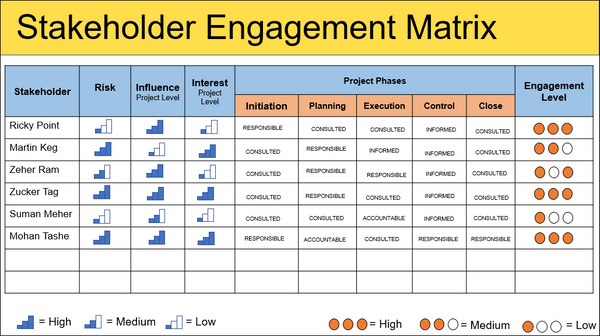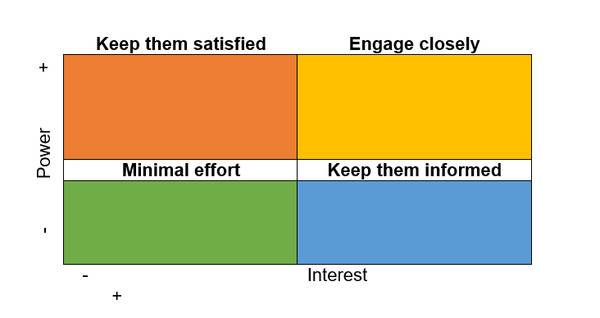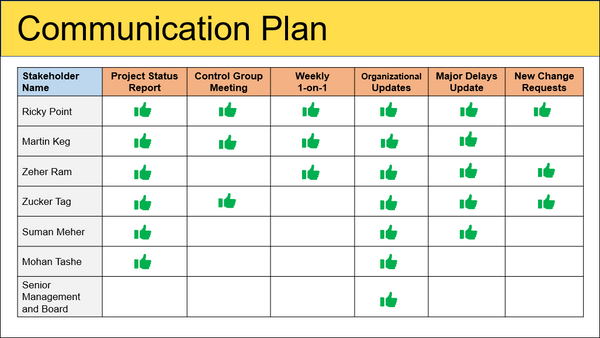Stakeholder Management Plan Template
Stakeholder Management Plan
Project management is a balancing act – and one that’s commonly misunderstood. In fact, nearly 50 percent of organizations express a poor understanding of project management, its various factors, and how those elements affect success.

Stakeholder Management Plan
Stakeholders, for instance, are key to the success or failure of any project. As project managers, we are responsible for overseeing and influencing relationships with key project stakeholders to increase the chances of a successful project outcome.
Project management is essentially about two things: making decisions and managing relationships. You can be a guru of MS Project or a master of PowerPoint presentations, but if you are not building and managing relationships in your project, trust me. You are very likely to have change requests, a demotivated team, poor buy-in, and an unhappy client.
What Is A Stakeholder?
Stakeholders represent individuals or groups that hold a stake in the project, either because they will be impacted by the project or because they have a vested interest in it. Even if it is an internal minor one, any project will have stakeholders, from the project’s client to the project’s team.
Stakeholders can be internal or external to the organization delivering the project and can vary greatly in number and type depending, of course, on the project's characteristics. However, typically you’ll find some of the following:
- Project sponsor
- Members of the project team
- Customer
- Suppliers
- Heads of departments
- End users
- Shareholders
- Unions
- Local communities
- Council and political representatives
- Competitors
- NGOs
- Professional organizations
What Is Stakeholder Management?
Each of the stakeholders above will have different requirements, different interests, different levels of influence, and different expectations towards the project. A project manager's challenging role is to align these expectations, engage the stakeholders, and promote their buy-in to the project. In summary, keep them happy.
To this process, we call Stakeholder Management: the systematic ability of the project manager to minimize negative stakeholder’s impact and to maximize their support by identifying, planning, communicating, and managing the expectations of the project’s stakeholders.

Stakeholder Management Plan Template
Each of these steps is developed in a Stakeholder Management Plan, a Stakeholder Management Plan Template ,a deliverable planning phase in the project life cycle.
Why Is It Important To Engage Stakeholders?
Being the project manager, there are so many activities and responsibilities that you already have (Read key project manager roles and responsibilities ). You may wonder why you need to worry about engaging stakeholders, one more item in your already extensive to-do list. Simple: because stakeholders can make or break your project. Thus, if you are not giving them all the TLC (tender loving care) they deserve, you may just be on your way to project failure.
Are you familiar with the story of the old man, the boy, and the donkey? Like in the bedtime story, projects are also difficult, or even impossible, to please everyone. That is why effective stakeholder management is so important, the art of the possible.
There are many reasons why you would want to engage your stakeholders, such as:
- More motivation, leading to more productivity, leading to a project delivered on-time.
- Better flow of communication, meaning that all know their role in the project.
- Less room for ambiguity, scope creep, or last-minute change requests since involvement from the early beginning means greater commitment and clarity.
- Quicker and more effective decision-making, since you don’t have to try to convince them every time about the project's benefits or why a certain change is necessary.
- Quicker and easier acceptance of change, since engaged stakeholders know what’s coming.
- Increased and extended buy-in since supportive stakeholders will be happy to speak about the project's benefits and sell the project's idea to others.
How To Create A Stakeholder Management Plan?
Managing stakeholder relationships, therefore, can only benefit from a formal stakeholder management plan. Establishing such a plan, in fact, can increase the likelihood of staying on-budget and on-schedule by seven percent.
Managing stakeholders is not something that you can reserve 5 minutes in your diary and gets done; rather, it requires time, skills, and, more importantly, planning, or, more specifically, a Stakeholder Management Plan.
The Stakeholder Management Plan documents and details who the stakeholders are, their vested interests in the project, their level of support, and their level of power/influence and interest, the best strategies mechanisms to promote their engagement.
Stakeholder Identification And Mapping
To correctly identify the stakeholders of the project is one of the most important activities to be carried out by the project manager, not only because it is easy to just think of the sponsor and other internal stakeholders and neglect the extended stakeholder’s possibilities, but also because there can be critical stakeholders where least expected (make no mistake: personal assistants or the security guard can be key stakeholders too!).
Above, I gave you a list of stakeholders that are typically found in any project. Having a prompt list in the organization – something your project management office (PMO) can assist with – is a good starting point, but you shouldn’t limit yourself to a quick check. Some questions that can be handy in identifying stakeholders include:
- Who will be affected by the project?
- Who is directly responsible for making decisions in the project?
- Who is influential in the area, organization, and in the scope/subject of the project?
- Who has been involved in the past similar projects?
- Who has not been involved but should have been?
- Who can obstruct a decision if not involved?
While stakeholder identification is not intended to be exhaustive, it should not be rushed or neglected either. So, additionally, you should consider the stakeholder's network. Stakeholders are not islands; they communicate and are influenced by one another. Hence, to maximize your chances of success, try to identify the individuals who have the power to influence your list of stakeholders.
Stakeholders identified can be listed under a Stakeholder Register, a separate document, or part of the Stakeholder Management Plan. Information to capture includes the stakeholders' name, their contact information, the organization they belong to, and their roles.
It is important to stress that identifying stakeholders is not a one-activity to be carried out just at the beginning of the project but should be a continuous activity throughout the project.

Stakeholder Impact Assessment
This section first identifies stakeholders. Research suggests that the most important stakeholders overall our clients, end-users, and suppliers, but this may vary by project. Next, it accurately and specifically defines the weight and impact of relationships with those stakeholders. This is important for a couple of reasons.
First, it helps a project manager identify how interested each stakeholder is in the project (positively or negatively), and second, their capacity to affect the project (again, positively or negatively). Neutral stakeholders matter, too, especially if they have a high level of potential to influence the project.
Stakeholder Analysis
Now that you have identified your stakeholders, it is time to analyze who they really are, their level of interest, what power they have, what their expectations are, and if they seem favorable or against the project.
This is done using what is commonly known as a power-interest matrix, where each stakeholder is plotted in the matrix based on their level of power to impact the project and their level of interest. All stakeholders are equal, but some are more equal than others.

Stakeholder Engagement Matrix
Depending on where each stakeholder fits in the matrix, different strategies apply to manage their engagement:
- Keep Them Satisfied: stakeholders in this group have little interest in the project but high power to continue or stop. Examples of such stakeholders include the financial department, which holds the budget for the project. The best engagement strategy is to meet their needs and keep them satisfied, which can mean invite them for project updates meetings occasionally or ensure that their communication requirements are being met.
- Minimal Effort: stakeholders who have little power and little interest in the project are the least important and require minimal effort from the project manager. However, they should not be totally overlooked: a stakeholder can move from a quadrant to another without notice!
- Engage Closely: stakeholders with a high level of power and a high level of interest are your most important stakeholders, the key players such as the project sponsor and the project client. These are the individuals that you will want to keep on your side, and that will require all the TLC you can provide, from conversations over lunch to pretty reports and 1-2-1 updates.
- Keep Them Informed: the last quadrant represents a scenario formed by stakeholders with low power but highly interested in the project. These are stakeholders to which you need to show consideration, such as the project end-users and whom you should keep informed, either by regular updates or via a newsletter, for instance.
It is important to note that this analysis is not static but rather dynamic. Changes happen in the hierarchy and structures of organizations; thus, stakeholders can move within different levels of power and interest throughout the project. Who your most important stakeholder is today can be a different stakeholder tomorrow.
Another element that should be part of your analysis is the level of support of each stakeholder: are they against, neutral, or in favor of the project? Try to understand the justification for their (lack of) support and use that information to build up their engagement. It may well be that a certain stakeholder is against the project because of a misunderstanding or poor communication. Do not make assumptions!
Check out our stakeholder analysis template here.
All the information above can also be captured as additional columns in the Stakeholder Register. Check out the stakeholder register template to capture all stakeholder details and information. Due to the Stakeholder Management process's nature, while you are mapping and analyzing your stakeholders, you may also want to develop a Communications Plan. This will ensure that you plan the right type of communication in line with the engagement strategy resulting from the power-interest analysis.
Conduct Risk Management Analysis
Like all aspects of project management, stakeholders must be considered as variables that carry and involve risk. Stakeholder mapping should provide answers to questions including:
- “What are this stakeholder’s needs?”
- “How important is this stakeholder to the project?”
- “What would happen if this stakeholder pulled out, and what would make that happen?”
Let’s take an example. A project manager sees that an upcoming deadline is approaching a little too quickly.
They can either (1) miss the deadline and stay on-budget, or (2) meet the deadline by slightly overspending. While thorough, adequate planning should minimize the risk of this scenario occurring, business unfortunately never transpires in a vacuum, and unexpected events make this kind of scenario more common than we’d like.
Back to the example above: the project manager needs to decide, so they look to their stakeholder risk analysis. They know that “Stakeholder A” has a major influence on the project's success, and they are highly concerned with meeting the deadline. “Stakeholder B” has a minor influence and is more concerned with staying on-budget.
Thanks to the project manager’s analysis of the questions above, they know that their best chances of success are to meet the deadline.
Management Of Stakeholder’s Engagement
The last step in the process involves actioning the Stakeholder Management Plan, monitoring its results, and adjust it accordingly throughout the project. Handling stakeholders – complicated ones – requires a specific skill set that involves excellent communication, influencing and resolving conflicts, problem-solving, and, the most important one, emotional intelligence.
Fundamentally, the project manager creates an environment for the project where stakeholders can feel comfortable expressing their concerns and expectations. The management of stakeholders' expectations involves, first of all, confirming what these expectations are so that they can be re-adjusted to the reality of the project.
There are key moments in the project where the project manager can re-set and reinforce expectations, which include:
- Project kick-off, In fact, a stakeholder meeting.
- Project charter (in particular, the scope statement)
- Project steering meetings
- Project team meetings
Managing expectations is a continuous effort, which also requires the project manager to factor in each stakeholder's cultural context, their capacity to engage (e.g., language barriers), and how well informed they are about the project. In fact, the stakeholder who is engaged and whose expectations are being well managed:
- Are fully informed about the project.
- Understand their role in the project.
- Sell to others the benefits that the project will deliver.
- Assist in removing obstacles in the project.
Create A Communications Plan – Then Maintain It
After identifying, analyzing, and prioritizing stakeholders, it’s time to establish communication plans. These plans will be different for each and every stakeholder. Obviously, that’s a lot of time investment, which means that it’s important to prioritize this stage to maximize the effect of time invested.

Communication Plan Template
Stakeholders rely on communication to continue their investment and to support a project’s goals. In case if you are interested in checking out the communication plan template, check here. Think carefully about what kinds of information each stakeholder needs. Are they interested in specific key performance indicators (KPIs)? Particular developmental landmarks? Not only is the information delivered to each stakeholder important, but also the delivery method.
Choosing a communication method – whether it’s one-on-one meetings, phone calls, teleconferences, or newsletters – affects the stakeholder’s reception of that information, and ultimately their investment.
Establishing good, ongoing stakeholder relationships will help maintain the effects of all the hard work already completed. Maintaining the communication plan means understanding how often communication should happen, who should be actually engaging the stakeholder, and the appropriate method of engagement.
Tips For Effective Stakeholder Management
- What’s In It For Them?: the best way to gain buy-in is to focus on the direct benefits of the project relevant to each stakeholder. Don’t simply present them the project's scope; find out how the project can work for them, that is, what’s in it for them.
- Learn What Makes Them Tick: everyone has a passion, a hobby, something, or someone who inspires us. Find out what makes your stakeholders tick and use that information in your favor to start a relationship and build rapport. You may even share common interests that you didn’t know about!
- Small Talk Is Big Talk: formal problems are very often solved through informal conversations. Don’t be afraid of small talk; actually, engage in it and make these 5-10 minutes conversations part of your daily job. If your project client is a football addict and his team just had a great match the day before, you may yourself score just by bringing the topic up.
- Keep Your Friends Close (And Your Enemies Closer!): remember, effective stakeholder management is about maximizing support and minimizing threats; thus, while it is important to keep your project supporters happy, it is even more important to monitor the difficult stakeholders who, if dominant, can influence the positioning of others. Watch out.
- One Does Not Destroy What One Helps To Build: a recognized way to gain engagement is to involve people in the project from its beginning because no one destroys what they were involved in building. Symbolic gestures such as asking a key stakeholder of his/her opinion, giving them a quick update phone call, or asking a colleague to review a document may seem small but can be sufficient to generate a sense of belonging to the project.
- Be Emotionally Intelligent: at the end of the day, all projects are made by people, with people, for people. Don’t forget that stakeholders are just ordinary people, like you and me, and like all people, they too have feelings, hopes, fears, and emotional needs. A good project manager recognizes this reality and uses empathy and positive emotions to drive behavior.
- Communicate, Communicate, Communicate: project managers spend up to 90% of their time communicating, and this is a crucial element for successful stakeholder management. As a project manager, you should ensure that your stakeholders' communication requirements are identified and are being met. And take note: communication is not only about speaking but mostly about listening!
- Be Authentic: authentic leaders inspire, act as role models, and generate a sense of trust. Stakeholder management should not be confused with stakeholder manipulation. Of course, there are strategies and a target behaviour or level of support that you are trying to achieve, but you should be authentic in your leadership style and in your communication.
- Every stakeholder management plan is different, but some tips are universal for improving the quality of that plan for project managers. Avoid common stakeholder pitfalls with tips including:
- Define expectations (i.e., financial investments, timelines) for stakeholders early – and stick to them.
- Keep a close eye on the future. Part of the mitigating risk is informing stakeholders of bumps in the road long before you hit them.
- Stakeholders are humans. Respect their time, feelings, unexpected life events, and outside commitments.
- Listen to stakeholder input – this establishes trust and investment over time.
- Engage high-priority stakeholders at their preferred level, whether communicating in a coffee shop or a formal meeting.
Effective project stakeholder management is a cornerstone of project success. Balancing stakeholder needs and the impact can be argued as important as establishing an effective business model. Identifying stakeholders, establishing an effective communication plan, and maintaining that plan can help maintain growth and promote new stakeholders to invest in a project's future.




